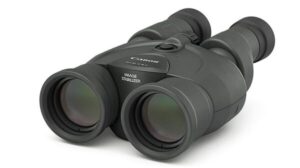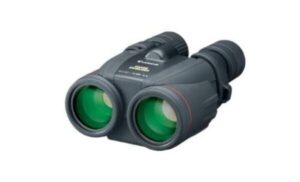In this review, we will delve into the world of astronomy covering the Best Image Stabilized Binoculars for Astronomy. These specialized binoculars offer a remarkable combination of magnification power and stability, allowing users to observe celestial objects with incredible detail and clarity
With Image Stabilized Binoculars you get stable images at high magnification without needing a tripod. Image stabilization will make sure you get solid images even when your target is flying, floating, rolling, rocking, and in other situations. With this technology smoother panning at different speeds is enhanced through compensation and correction of movements and shakes.
Here are the best image-stabilized binoculars for astronomy
Best Image Stabilized Binoculars for Astronomy-Our Top Picks
1) Canon 12×36 Image Stabilization III Binoculars

Canon 12×36 is one of the Best Image Stabilized Binoculars for Astronomy. These binoculars are portable and compact making them suitable for hunting, watching sports events, bird watching, hiking, and more.
Canon’s advanced Image Stabilization achieves stability in high magnification without using a tripod, this technology features Vari-Angle prisms between the front lens and the main prism for compensation and correction of shakes and movements for smoother panning at different speeds. This technology also features a high-performance microcomputer to improve image stabilization, efficient energy consumption, and shorten startup time.
The 36mm/1.42 in. objective lens is very effective in the provision of bright, clear, and high-resolution images while the Porro II Prisms provide incredible image resolution reduces light loss. Sharp and distortion-free images are also enhanced by the doublet field-flattener.
Features
- Advanced Image Stabilization (IS) technology
- Water-resistant and non-slip rubber coating
- Sharp and steady views
- Extra bright field of view
- Environmentally-friendly lead-free glass
- Versatile and powerful
- Lightweight and compact
- 36mm/1.42 in objective lens diameter
- Porro II Prism design
- Comfortable for Longer Periods of Use
- 12x magnification
- Long eye relief (14.5mm/0.57 in.)
- Enhanced power-saving technology
2) Fujinon Techno Stabi TS1440-14×40 Image Stabilization Binocular

Unique and reliable performance is what you get when you use these binoculars. The binoculars come with a strengthened mil-spec hard plastic carrying case that is very robust and rugged.
The binoculars lock in on the target to deliver a view that is stabilized at high magnification. To ensure maximum transmission of light, they have a patented EBC coating. The ±5° Image Stabilization will help you lock in on subjects for stabilized views at high levels of magnification, You are certain of getting a solid image of any view whether it’s flying, floating, rocking, or rolling.
Besides that, the binoculars have waterproof and fog proof capabilities which makes them ideal to use regardless of the weather condition. This also means that you can have peace of mind when caught up by unexpected weather. A protective rubber armor ensures a firm and secure grip for the user.
Features
- Waterproof and fog proof
- ±5° Image Stabilization
- Comes with a reinforced mil-spec hard plastic carrying case
- Rubber armor provides a firm and secure grip
- Phase coated
- Center Focus
- Powered by 4x AA type alkaline batteries
- Patented EBC coating for exceptional light transmission
3) Canon 10×42 L Image Stabilization Waterproof Binoculars

These are the first waterproof binoculars to integrate Canon’s exclusive Image Stabilizer technology. With these binoculars, you get outstandingly bright views even in dim conditions thanks to the large lens and exit pupil. Optics are of premium quality and have ultra-low dispersion lens elements on both sides for impeccable correction for chromatic aberration.
Additionally, they are waterproof. A metallic coating covers the body components to deter fogging. They also have the Doublet Field Flattener Lenses for sharp and non-distorted images edge to edge. These binoculars also bring to the table an elegant design that is easy to grip.
Features
- Waterproof and fog proof
- Bright field-of-view
- Doublet Field Flattener Lenses for sharp images
- 4.2mm exit pupil
- 65° view angle
- One-touch IS usage
- Offers bright views even in dim conditions
- Ultra-low Dispersion elements on each side
- Distinctive and easy-grip design
4) Fujinon 14×40 TSX1440 Techno-Stabi Image-Stabilized Binoculars

With a ±6° vibration correction angle these binoculars are known to give a remarkable and outstanding optical performance for bright, clear, and stabilized astronomy, music vents, spectator sports, wildlife, and more. Fujifilm is known for next-level optical designs and technologies and this is what you get with these binoculars.
Light gathering is enhanced by the 40mm objective lens while the EBC Multi-Coating controls flare, chromatic aberration ghosting for bright and clear views. The design is stylish and easy-to-hold while the construction is moisture-resistant. For a firm grip, these binoculars feature slip-resistant rubber coats.
Features
- ±6° vibration correction angle
- 40mm objective lens
- Perfect for astronomy and low-light conditions
- Advanced light-gathering power levels
- EBC Multi-Coating
- Edge-to-edge sharpness
- Water and fogproof
- Rubber armored body
- Porro Prism
5) Fujinon Techno-Stabi TS12x28 Image Stabilization Binocular

Fujinon Techno-Stabi TS12x28 Image Stabilization Binoculars are powerful and deliver exceptional performance. These binoculars use Optical Stabilization technology to reduce the synergistic vibration that typically comes about just from holding the gadget. They have the capability to deliver stable images without needing a tripod.
The binoculars have a lightweight, compact and ergonomic design which makes them easy to carry and perfect for astronomy where the user may want to use a higher magnification. This attribute also ensures a comfortable viewing experience for extended sessions.
In addition, optics are multi-coated for excellent transmission of light which is perfect for low light conditions for bright and sharp images. The phase-coated prisms also ensure high contrast images. The precise center focus wheel brings details into sharp focus just by moving the finger. You get a long battery life of up to 12 hours with a CR2 lithium battery.
Features
- ±3 Degree vibration correction range
- 12x magnification
- 2.5mm Exit Pupil
- Auto-off function
- 28mm objective lens
- Optical Stabilized technologies
- Delivers stable images without a tripod
- Lightweight and compact design
- Multi-coated optics for optimal light transmission
- Phase-coated prisms deliver high contrast images
- Long battery life
See Also
- 5 Best Binoculars for Moon Watching/Moon gazing
- 6 Best 20×80 Binoculars for Astronomy and Stargazing
- 6 Best 70mm Binoculars
Types of Binocular Image Stabilization Systems
- Active Systems-Binoculars with an active system can adjust an image automatically using an electric sensor. When the sensor detects a change in altitude, it changes the lens or the angle of the prism to redress the image view. They generally alter the mechanism of the binoculars electronically when a change in latitude takes place to ensure a steady field of view at all times.
- Passive systems-Passive systems do not have an electronic sensor. An image is usually manually adjusted using a gyroscope or by freeing the prism from the housing. Binoculars with passive systems are normally used for observing moving objects like boats and airplanes. The system works well with high-magnification binoculars and video and camera lenses as well.
Choosing the Best Image Stabilized Binoculars for Astronomy
Aperture
Aperture refers to the opening from which light passes and enters into the binoculars. Effectively, it is the size of the lens of the binoculars. The aperture size heavily depends on your purpose of use. For astronomy, a minimum of 60mm is great. The larger the aperture the more the light transmission.
Magnification
Magnification is a key factor when buying image-stabilized binoculars for astronomy. Most IS Binoculars have higher magnification than standard ones. This is because IS binoculars are made to capture objects that are in motion or those that are found at very long ranges.
Lens coating
Most of these binoculars come with coated lenses for clear viewing. The more the coatings on the lenses, the brighter and sharper the images. Binoculars with multi-coated lenses are perfect in weather conditions where it is difficult to see anything.
Image clarity
Binoculars are basically useless if they cannot deliver clear images. Any standard binocular should be able to provide clarity within a certain distance. Image Stabilization binoculars are made to deliver clearer, sharper, and brighter images. So, keep clarity in mind when buying these binoculars. Clarity depends on the lens’ coating, and magnification among other features.
Budget
IS binoculars are more expensive than most standard binoculars. Compare the pricing as they vary depending on the model. It is still possible to get some quality ones that don’t cost a bomb. However, this all depends on what you can and cannot afford. On average, most Image Stabilization binoculars are rather costly but some are more affordable than others. The price also depends on the brand, Some of the best brands include Canon and Fujinon.
Construction
Get binoculars that are waterproof, fog-proof, and shockproof. Do not limit yourself by purchasing binoculars that only perform in certain conditions. If they are weatherproof, they will give you peace of mind in case you are caught up in expected weather conditions. They will also give you the confidence that you need to use them in all weather conditions.
Why We Chose the Above Binoculars
- More stable-These binoculars are more stable to use than a standard pair of binoculars. Even people with the steadiest of hands may strain when it comes to astronomy, where stability is requisite. So, shaky hands will be a thing of the past. You will also not need a tripod with these binoculars.
- Easy to use-Image Stabilized binoculars are easy to use as they automatically refocus every time your arm moves and give you a better view of the stunning night sky with much less effort.
- Minimize eye fatigue-Eye fatigue is a common issue for amateur astronomers. These binoculars ensure that your eyes don’t need to work overtime.
- Durable-The binoculars are built of premium materials that make them last for a long time
- Multi-purpose-Besides astronomy, image-stabilized binoculars can be sued for sports events, watching birds, safaris, and observing moving objects such as airplanes and boats.
FAQs
- Are image-stabilized binoculars worth it?
Yes absolutely. They are a good choice, particularly for people interested in using their binoculars for highly magnified viewing.
- How does image stabilization work in binoculars?
Image-stabilized binoculars stabilize the image by manipulating the lenses to continuously compensate for the movement of the device in your hands. This is achieved using an internal gyroscopic mechanism or with electronic sensors coupled to microprocessors that adjust instantly for any motion.
- How should I clean my binoculars?
Binoculars accumulate dirt in their lenses from time to time as they are frequently used. The housing or casing may also contain dirt. Use a clean piece of cloth to wipe the housing so as to get rid of the dirt. A soft cleaning brush is good for the lenses. You need to be gentle with the lenses as they have a delicate coating. Always clean them as occasionally as possible. Luckily, most binoculars come with a cloth that can be used to clean them with.
Conclusion
We know that stabilized binoculars are quite expensive and getting the best will make sure you get value for the investment. Our list has the best on the market. We hope that our guide will be of great help.

